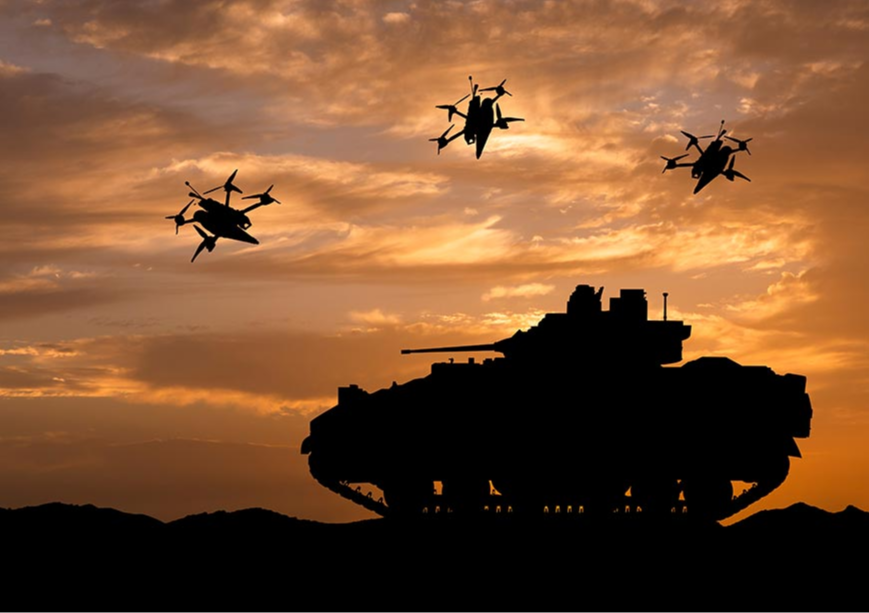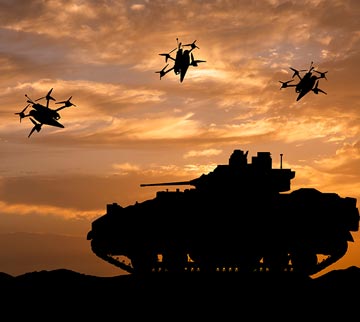
This article is part of a series—Raisina Edit 2024
Revolution in Military Affairs (RMA) is a buzzword that militaries around the world are familiar with. Each generation of the military has encountered and adopted new technologies that intersect with changing doctrine, strategy, and tactics to bring about irreversible changes in the nature of warfare.
Every major war fought in the 20th century involved an RMA. The deployment of machine guns changed the nature of trench warfare during World War I, as well as Blitzkrieg tactics and highly maneuverable tanks and mechanized platforms during World War II. During the first Gulf War, the United States brought the idea of RMA to the forefront by easily routing Saddam Hussein's forces using high-tech standoff capabilities such as Tomahawk cruise missiles and carrier-based air power.
Today, network-centric warfare has taken center stage. In the modern battlefield, the realms of artificial intelligence (AI), space, and cyber are converging with sensors, unmanned aerial vehicles (UAVs), and beyond visual range (BVR) weapons, creating a sensor-to-shooter (STS) kill chain. has decreased significantly.
The deployment of machine guns changed the nature of trench warfare during World War I, as well as Blitzkrieg tactics and highly maneuverable tanks and mechanized platforms in World War II.
There are many lessons left in the battlefields of the past. Modernization is a process. Technological and doctrinal advances and corresponding changes in organizational structure are add-on layers.
Today's world situation is characterized by instability and uncertainty. Trade and technology have been weaponized. Territorial conflicts are becoming more prominent, as seen in the wars between Armenia and Azerbaijan, Russia and Ukraine, and more recently in the conflict between Israel and Hamas in the Gaza Strip.
The first lesson of the war between Armenia and Azerbaijan is the overwhelming difference that drones can make on the battlefield. Armed with an outdated and disjointed air defense system, Armenia had no answer for the havoc that Azerbaijan's Turkish-made Bayraktar TB2 drones and Israeli kamikaze drones inflicted on its troops and tanks. Azerbaijani drones successfully destroyed many Armenian air defense systems, which appeared to lack electronic warfare (EW) capabilities.
Drones are inexpensive to obtain and operate. Smaller versions can be carried by individual soldiers and deployed on the battlefield. Drones firmly established themselves in the era of network-centric warfare, especially during the Ukraine war. The deployment of Ukraine's Bayraktar TB2 drone initially proved effective against Russia, but also spurred the development of counter-drone systems in the future.
Smaller versions can be carried by individual soldiers and deployed on the battlefield. Drones firmly established themselves in the era of network-centric warfare, especially during the Ukraine war.
The war between Israel and Hamas, like the Ukraine war, has brought unexpected lessons from the battlefield. Hamas planned simultaneous attacks using low-cost rockets, commercially available drones, paragliders, bulldozers, trucks, and even motorcycles to overwhelm the Israeli military's most advanced ISR capabilities. Apparently, Israel's sophisticated Iron Dome system and state-of-the-art SAR (synthetic aperture radar)-enabled Ofeq-13 observation satellite, multiple sensors, radars and air defense systems could be overwhelmed by a flood of rockets. The inference is that there is. As part of his tactics, Hamas effectively used multiple low-tech platforms to penetrate Israel's security perimeter. Another takeaway from this conflict is the widespread use of tunnels to evade detection, store ammunition, and serve as bases for counterattacks.
The war between Russia and Ukraine has witnessed the use of cyberspace to carry out distributed denial-of-service (DDoS) attacks against enemy countries' critical infrastructure, including support from regime-aligned non-state actors.
The conflict between Israel and Hamas has also taken propaganda warfare to a whole new level. Civil society organizations, especially young people and NGOs around the world, are developing new loyalties that often run counter to state positions. This exploitation of emotions is facilitated by social media platforms and deep fakes. One notable example during the Ukraine war was an AI-generated deepfake of President Zelenskiy surrendering to Putin. Although this was quickly debunked by the Ukrainian government and media, it did highlight the future dangers of deepfake technology as AI grows.
Civil society organizations, especially young people and NGOs around the world, are developing new loyalties that often run counter to state positions.
Another interesting lesson from recent conflicts is the use of civilian internet systems and commercially available satellite imagery integrated with open-source information on troop movements and military build-up. Ukraine has used Elon Musk's SpaceX Starlink satellite terminal as a digital lifeline for soldiers and to launch attacks. For the first time in modern history, Big Tech owners like Musk are taking on the challenge of not only providing the military with critical communications platforms, but also advising users on war tactics. Denial of such services by commercial vendors could affect the outcome of the war. One example is Musk's denial of the use of the Starlink network when Ukraine was planning a surprise attack on Russian military establishments in Crimea.
Ukraine's use of the US-made Javelin anti-tank bullet against Russian tanks was one of the most visible highlights of the conflict. A video shared on social media by Ukraine's 36th Marine Brigade showed dramatic drone footage of Ukrainian soldiers firing a mobile anti-tank system FGM-148 with deadly effect on a Russian tank column. . This sparked a discussion about the impending obsolescence of the tank. Undoubtedly, every technological advance on the battlefield creates countermeasures. New technologies emerge to negate the advantages of adversaries in a never-ending cycle of competition. Javelins are not only more expensive, but also have longer delivery times. Moreover, Russia appears to have more tanks than Ukraine can field Javelins.
Technological struggles on Ukraine's battlefields are breaking new ground, including the use of AI-based image processing and facial recognition software. The use of 3D printing of spare parts and delivery to immobilized tanks on the battlefield using semi-autonomous delivery systems is also in the future, as demonstrated by the United States during Project Convergence 21 at the Yuma Proving Ground in 2021. has emerged as a factor in the war. .
Communications, encryption and decryption are also at the heart of the technology wars. Ukraine uses commercial AI-enabled speech transcription and translation services to process intercepted Russian communications.
Technological struggles on Ukraine's battlefields are breaking new ground, including the use of AI-based image processing and facial recognition software.
In the future, natural language processing (NLP) translation capabilities for individual soldiers may become the norm. Such capabilities could also emerge as soldier support systems that help enhance direct communication and confidence-building measures across the front lines.
Modern warfare does not always guarantee complete victory. The role of asymmetric and destructive tools and the support of non-state actors often help counter modern technologies. At the same time, waging a war of attrition can be costly. Western military powers are experiencing a sharp decline in their stocks of 155 mm artillery shells. As a result, Ukraine's supply is lower than Ukraine's consumption.
This particularity of shortages in conflicts involving great powers and their allies has led to the emergence of new defense suppliers. For Western countries, the Republic of Korea (ROK) has emerged as a major supplier of artillery shells. Russia is procuring Shahed-136 drones from Iran and artillery shells from North Korea.
Ukraine currently does not have an air force comparable to Russia's, and Russia does not fully field its own air force. Maximizing the use of air power by either side could change the course of the war, but it could also draw NATO into the fray. The lesson here is that air power is often used selectively, even in desperate situations, to avoid escalation.
Today, advanced space, cyber, and AI technologies exist seamlessly with solid frontiers that reflect the past. The difference is that soldiers in the trenches are now an integral part of internet-centric warfare.
Ambassador Sujan R. Chinoy He is the Director of Manohar Parrikar Institute of Defense Studies and Analyzes (MP-IDSA), New Delhi.
The above views belong to the author. ORF research and analysis is now available on Telegram. Click here to access our carefully selected content (blogs, long-form articles, interviews).


